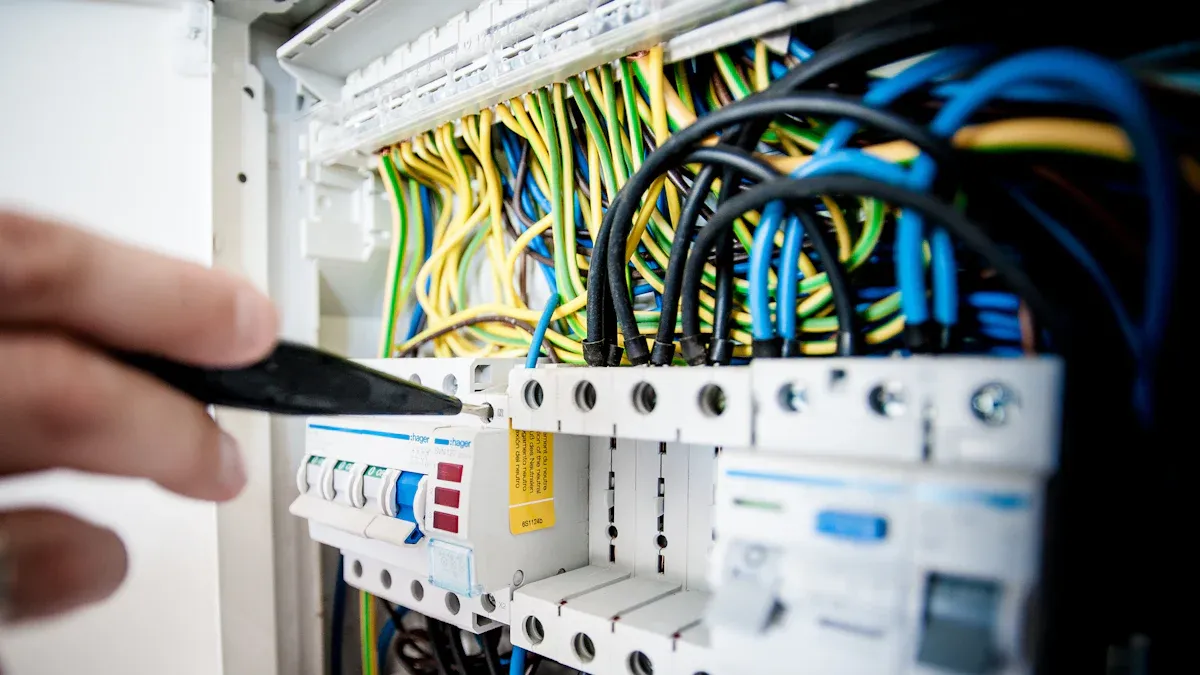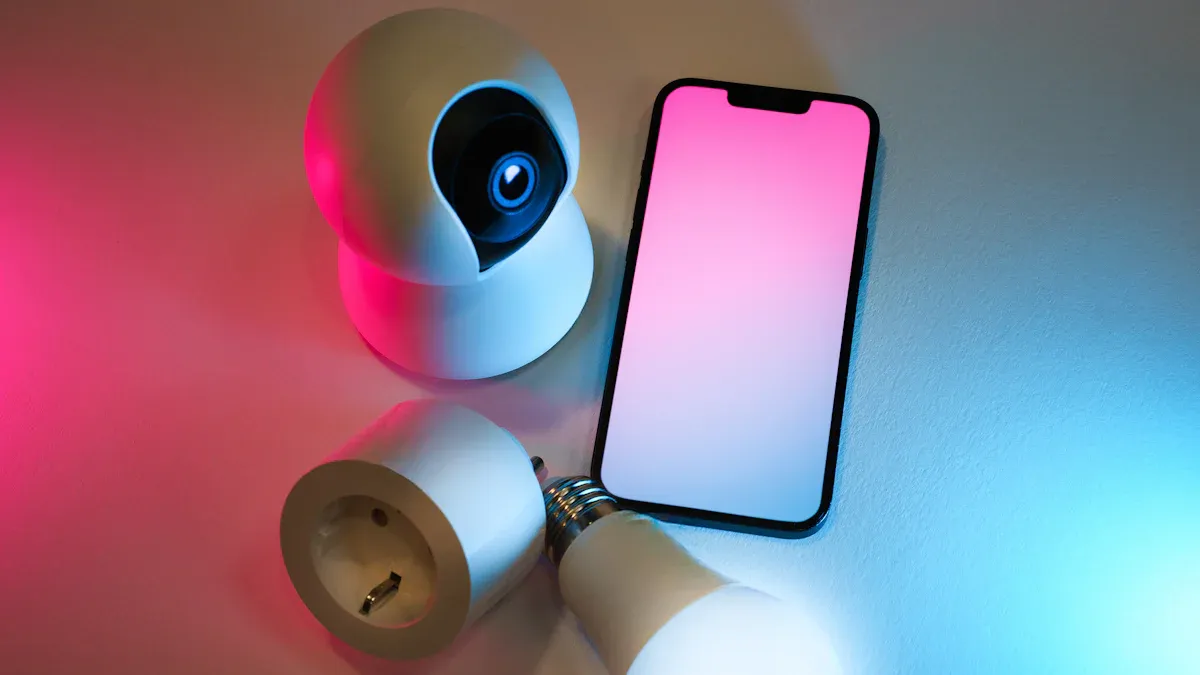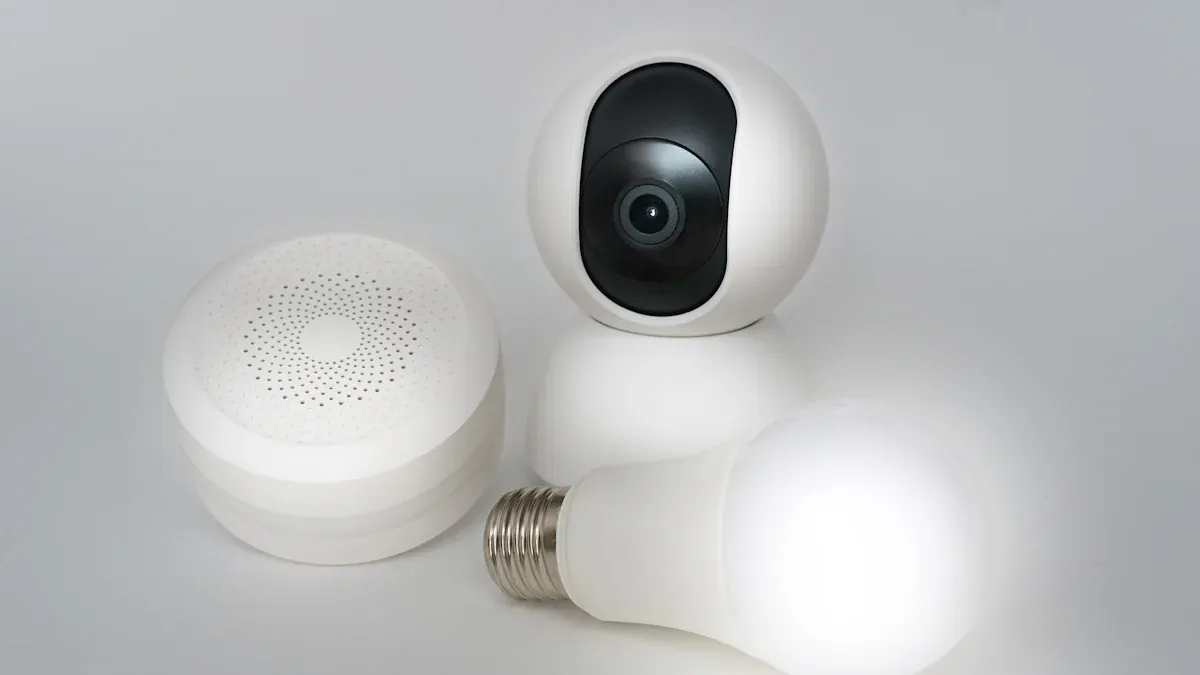Understanding Lighting Control Panels: Features, Installation, and Integration with Wireless Systems

Lighting control panels help manage today’s lighting systems easily. These panels let you adjust brightness, timing, and how lights work. They save energy by using lights smartly and avoiding waste. You can set them up to match your schedule or mood. At home or work, they make lighting simple and efficient.
Key Takeaways
Lighting control panels help you change brightness and set timers. This makes lighting work better and fit your needs.
Dimming lights can improve spaces. Use bright light to work and soft light to relax.
You can control lights with your phone from anywhere. This is easy and helps save energy.
Smart home systems work with lighting panels for better control. You can use voice commands and set automatic actions.
Picking the right lighting panel saves a lot of energy. Studies show it can cut energy use by up to 60%.
Key Features of Lighting Control Panels

Lighting control panels have features that make managing lights easier. These features help save energy and lower costs. Below are some important functions.
Dimming and Brightness Control
You can change how bright your lights are with dimming. This lets you pick bright light for work or soft light for relaxing. New panels use advanced methods for smooth brightness changes.
Linear Dimming Curve: Light changes evenly as you adjust the dimmer.
Non-linear Dimming Curves: These match how people naturally see brightness.
Custom Dimming Curves: These are made for special uses to improve lighting.
Setting up dimming systems correctly is very important. This setup adjusts the system to work perfectly after installation. For example, it may involve setting timers or fixing dimming for certain bulbs. Companies are making this process simpler, so you can get the lighting you want easily.
Scheduling and Automation
Scheduling lets you set times for lights to turn on or off. Lights can brighten in the morning and dim at night automatically. This makes your daily routine smoother.
Timed schedules save a lot of energy. Studies show they cut lighting energy use by 24%. Adding motion sensors can save even more, reducing energy use by up to 68%. These tools save energy and lower your bills.
Remote Access and Control
Remote control lets you manage lights using your phone or tablet. This is helpful if you forget to turn off lights when leaving. You can change brightness, set schedules, or check energy use easily.
Smart lighting systems with remote control can cut LED energy use by over 50%. They also work well with other smart devices in your home. You can adjust lights while away or make sure your house is lit before you arrive. This feature adds convenience to modern living.
Energy Efficiency and Cost Savings
Lighting control panels help save energy and lower bills. They manage when and how lights are used, saving money without losing comfort.
Adaptive lighting controls are a big energy saver. These systems change light levels based on the time or sunlight. For example, on sunny days, indoor lights can dim to use less power. This saves energy and makes bulbs last longer.
Tip: Use LED bulbs with your lighting panel. LEDs use 75% less energy and last longer than regular bulbs.
These panels also stop energy waste. Motion sensors turn lights off when no one is in the room. This avoids wasting electricity when you forget to switch off lights.
Scheduling lights is another way to save money. You can set lights to turn off when no one is home or during quiet hours. This stops lights from staying on by accident, which can cost extra.
The U.S. Department of Energy says advanced lighting controls can cut energy use by 60%. This saves money and helps the planet by using less energy.
Integration with Smart Home Systems
Connecting lighting panels to smart home systems makes life easier. You can link them to smart speakers, thermostats, and security devices for a connected home.
Voice control is a favorite feature. With Alexa or Google Assistant, you can control lights by speaking. For example, say, "Turn off the kitchen lights," and it happens instantly.
Smart homes also allow scene settings. With one tap or command, you can set lighting moods. For instance, create a "movie night" scene with dim lights or a "study mode" with bright lights.
Note: Make sure your lighting panel works with your smart devices. Look for support for Zigbee, Z-Wave, or Wi-Fi.
Remote control is another great feature. Using an app, you can manage lights from anywhere. This is helpful for safety, like turning lights on while you're away to make it look like someone is home.
By linking lighting panels with smart systems, you get more than convenience. You create a home that’s energy-saving, secure, and fits your lifestyle.
Installation of Lighting Control Panels
Tools and Things You Need
To install lighting control panels, you need some tools. Grab screwdrivers, wire strippers, and voltage testers. For wired setups, you’ll also need electrical tape and connectors. Wireless systems might need a hub or gateway to work.
Before starting, check your home’s wiring. Turn off the circuit breaker to stay safe. Read the manual carefully for step-by-step instructions. Each panel model has its own setup guide.
Tip: Use a multimeter to check wires. It helps ensure the voltage is correct and connections are safe.
How to Install Wired Systems
Wired systems are steady and reliable. Pick a spot near your main electrical box for the panel. This makes it easier to connect.
Steps to follow:
Turn off the power to stay safe.
Securely attach the panel to the wall.
Match and connect wires as shown in the manual.
Use a multimeter to test the connections.
Turn the power back on and check if it works.
Be careful with wired systems. Wrong wiring can cause problems or be dangerous. If you’re unsure, ask a professional for help. They’ll make sure everything is done right and works well.
How to Install Wireless Systems
Wireless systems are simpler to set up. You don’t need to do much wiring. Place the panel in the middle of your home for a strong signal.
Steps to follow:
Power the panel with batteries or plug it in.
Connect it to Wi-Fi or a smart hub. Follow the app’s steps to pair it.
Test it by using the app to control the lights.
Wireless systems are flexible. You can move the panel if needed. But weak signals or interference can cause issues. A professional can help fix these problems. They’ll set it up smoothly and customize it for your needs.
Overcoming Common Installation Challenges
Setting up lighting control panels can seem hard at times. But with the right steps, you can fix most problems. Here are some common issues and how to solve them:
Incorrect Wiring Connections: If lights don’t work, check the wiring again. Use a multimeter to make sure wires are connected properly.
Compatibility Issues: Some panels might not fit older wiring or certain lights. Before buying, check if the panel works with your home’s system.
Weak Wireless Signals: Wireless systems may have weak signals causing delays. Put the panel in the center of your home. Avoid thick walls or metal objects nearby.
Software Setup Problems: If the app won’t connect, check your Wi-Fi. Restart the app or reset the panel if needed.
Tip: Always read the manual carefully. It has troubleshooting steps for your panel.
By solving these problems one at a time, your lighting panels will work well.
DIY vs. Professional Installation
Should you install it yourself or hire a pro? It depends on your skills and the system’s difficulty.
DIY Installation: If you know basic tools and wiring, try it yourself. Wireless panels are easier for beginners. Follow the manual and turn off power for safety.
Professional Installation: For harder setups, hire an electrician. They’ll wire it correctly, avoid mistakes, and save you time. They can also connect panels to smart home systems.
Note: DIY is cheaper, but mistakes can cost more later. If unsure, hiring a pro is a safer choice.
Picking the right option keeps your lighting system safe and working perfectly.
Integration with Wireless Systems

Advantages of Wireless Integration
Wireless systems make controlling lights easy and flexible. You can use your phone or tablet to manage lights from anywhere. This means no need for wall switches, and you can adjust settings remotely.
Installing wireless systems is simpler than wired ones. They don’t need heavy electrical work. Place the control panel in a central spot without running cables through walls.
These systems also save energy. Wireless lighting can cut energy use by up to 69.6%, as shown below:
Metric | Value |
|---|---|
Energy Savings | Up to 69.6% |
CO2 Emissions Avoided | 30.5% |
PayBack Period (Proposed) | 5 years |
PayBack Period (Commercial) | 9 years |
Wireless systems help the environment by lowering CO2 emissions. Over time, they save money with smaller energy bills and longer-lasting bulbs.
Wireless systems are easy to change or expand. You can add more lights or move the setup without rewiring. This makes them great for homes and businesses needing flexible solutions.
Compatibility with Wireless Protocols
Wireless lighting panels use special communication methods to work smoothly. These methods must match your home or office system for everything to work well.
Here’s a table of common communication types:
Communication Type | Description |
|---|---|
Hard-wired, low-voltage | 0 – 10 volt DC, analog control |
Line-side, line-voltage control | Control using line voltage |
Line-side, low-voltage, three-wire control | Control using a three-wire system |
Wireless (e.g., Zigbee) | Wireless communication protocol for lighting |
Line-side, power-line carrier control | Control using power line carrier technology |
Hard-wired, low-voltage, DALI control | Digitally Addressable Lighting Interface control |
Zigbee is a popular wireless method for lighting systems. It uses little power and works reliably. Other methods like Wi-Fi and Z-Wave also connect well with smart home devices.
When picking a lighting panel, make sure it supports your system’s method. This avoids problems and ensures smooth operation.
Practical Use Cases for Wireless Lighting Control
Wireless lighting panels can be used in many ways. Here are some examples:
Home Automation: Set up lighting scenes for activities. For example, dim lights for movies or bright lights for reading.
Energy Management: Schedule lights to turn off during the day or when rooms are empty. This saves energy and lowers costs.
Security Enhancement: Control lights from far away to make your home look occupied. This keeps intruders away and improves safety.
Commercial Spaces: Businesses can use wireless systems to manage lights in offices or stores. Motion sensors and timers ensure lights are only on when needed.
Wireless systems also work with smart home devices. You can connect them to voice assistants like Alexa or Google Assistant for easy control. This makes life more convenient and enjoyable.
By using these ideas, you can get the most out of wireless lighting panels in your daily life.
Fixing Wireless Connection Problems
Wireless lighting systems are handy but can have connection troubles. You can fix these by finding the cause and using simple solutions.
1. Check Signal Strength
Weak signals can make lights slow or not work. Put the control panel in the middle of your home for better coverage. Keep it away from thick walls, metal, or electronics that block signals. If it still doesn’t work, try a Wi-Fi booster or mesh network to improve the signal.
2. Update Software
Old software can cause problems. Update the control panel’s firmware and the app you use. Companies often release updates to fix bugs and make things work better. Check the app settings or the company’s website for updates.
3. Reduce Network Traffic
Too many devices on Wi-Fi can slow things down. Disconnect devices you don’t use or switch to a less busy Wi-Fi channel. If your system works with Zigbee or Z-Wave, use those to take the load off your Wi-Fi.
4. Restart Devices
A quick restart can solve many problems. Turn off the control panel and restart your Wi-Fi router. Follow the setup steps again to reconnect. This often fixes small issues.
5. Check for Interference
Other devices like microwaves or cordless phones can mess with signals. Move these away from your control panel. If the problem continues, switch to a 5 GHz band if your system allows it.
Tip: Keep a troubleshooting guide nearby. Most companies provide easy steps to fix common problems.
By solving these one at a time, your wireless lighting system will work better.
New Trends in Wireless Lighting
Wireless lighting is getting smarter and easier to use. New ideas are making these systems better every day.
1. Smart AI Lighting
AI is making lighting systems smarter. These systems learn your habits and adjust lights for you. For example, they can brighten in the morning or dim at night. This saves energy and makes life easier.
2. Voice Commands
You can now control lights by talking. Voice assistants like Alexa or Google Assistant let you change lights with simple commands. This is helpful for everyone, especially people with mobility issues.
3. Energy Harvesting
Some systems now power themselves using energy from light or motion. This means no batteries are needed, which is better for the environment and easier to maintain.
4. Works with Smart Devices
Wireless lighting can now connect to other smart devices. For example, lights can turn on when a security camera sees movement. This makes your home more automated and convenient.
5. Better Security
As systems grow, keeping them safe is important. Companies are adding stronger security features like encryption to protect your data. This keeps your lighting system and other devices secure.
Note: Learn about these trends to choose the best system for your home.
By using these new ideas, you can have a smarter, safer, and more efficient lighting system.
Lighting control panels are important for today’s lighting systems. They make lighting easier, save energy, and let you customize settings. Adding wireless systems makes them more flexible and cheaper to install. Studies show wireless systems are growing fast because they work well with smart homes and are simple to use:
Source | Key Findings |
|---|---|
Grand View Research | Wireless systems are growing fast due to flexibility, easy setup, and smart home use. |
Fortune Business Insights | Wireless options are growing the most because they fit smart homes and cost less to install. |
Data Horizon Research | More people want wireless systems for homes and small businesses since they’re easy to set up. |
Pick a lighting panel that fits your needs. Research shows personal lighting control makes people happier and work better. For instance, the California Energy Commission found automatic lighting saves 35-45% of energy in offices. Dimming lights by hand also saves energy and lets you adjust brightness to your liking. Choosing the right panel gives you an easy-to-use, energy-saving system that works perfectly for you.
FAQ
What’s the difference between wired and wireless lighting panels?
Wired panels connect straight to your home’s electrical system. They are steady but need more work to install. Wireless panels use Wi-Fi or Zigbee. They’re simpler to set up but might have signal problems in some places.
Can I set up a lighting control panel myself?
Yes, you can if you know basic electrical skills. Wireless panels are easier for beginners to handle. Always read the manual and turn off power first. For tricky wired setups, hiring an expert is safer and ensures it’s done right.
Do lighting panels work with all kinds of bulbs?
Not every panel works with all bulb types. Check the product manual for a list of compatible bulbs. Most modern panels work well with LED, CFL, and regular bulbs. Using the right bulbs helps the system work smoothly.
How do I fix a lighting panel that’s not working?
First, check the power and wiring connections. For wireless panels, make sure it’s connected to the network and within range. Update the software if needed. If it still doesn’t work, check the troubleshooting guide or call customer support.
Are lighting control panels good for saving energy?
Yes, they save energy by setting schedules, dimming lights, and using motion sensors. Adaptive systems adjust brightness based on sunlight, cutting energy use. Pairing them with LED bulbs saves even more and lowers your bills.
See Also
Effective Strategies for Integrating Light Commercial Electrical Systems
Advantages and Care Tips for LED Parking Lot Lighting
Design and Install Flood Lighting Systems for Any Property
Understanding LED Street Lights: Advantages and How to Implement
Choosing GE LED Light Bulbs: Features and Benefits Explained

